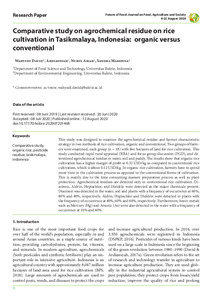Comparative study on agrochemical residue on rice cultivation in Tasikmalaya, Indonesia: organic versus conventional
| dc.date.accessioned | 2020-08-24T12:39:44Z | |
| dc.date.available | 2020-08-24T12:39:44Z | |
| dc.date.issued | 2020-08-12 | |
| dc.identifier | doi:10.17170/kobra-202007201468 | |
| dc.identifier.uri | http://hdl.handle.net/123456789/11716 | |
| dc.language.iso | eng | |
| dc.rights | Urheberrechtlich geschützt | |
| dc.rights.uri | https://rightsstatements.org/page/InC/1.0/ | |
| dc.subject | Comparative study | eng |
| dc.subject | pesticide residue | eng |
| dc.subject | organic rice | eng |
| dc.subject | soil | eng |
| dc.subject | water | eng |
| dc.subject | organic | eng |
| dc.subject | Tasikmalaya | eng |
| dc.subject | Indonesia | eng |
| dc.subject.ddc | 630 | |
| dc.title | Comparative study on agrochemical residue on rice cultivation in Tasikmalaya, Indonesia: organic versus conventional | eng |
| dc.type | Aufsatz | |
| dcterms.abstract | This study was designed to examine the agrochemical residue and farmer characteristic strategy in two methods of rice cultivation, organic and conventional. Two groups of farmers were examined, each group (n = 18) with five hectares of land for rice cultivation. This study conducted rapid rural appraisal (RRA) and focus group discussion (FGD), and determined agrochemical residue in water, soil and paddy. The results show that organic rice cultivation has a higher margin of profit at 0.32 USD/kg as compared to conventional rice cultivation, which is about 0.12 USD/kg. In organic rice cultivation, farmers have to spend more time in the cultivation process as opposed to the conventional forms of cultivation. This is mainly due to the time-consuming manure preparation process as well as plant protection. Agrochemical residues are detected only in conventional rice cultivation. Diazinon, Aldrin, Heptachlor, and Dieldrin were detected as the major chemicals present. Diazinon was detected in the water, soil and plants with a frequency of occurrence at 60%, 80% and 40%, respectively. Aldrin, Heptachlor and Dieldrin were detected in plants with the frequency of occurrence at 40%, 60% and 60%, respectively. Furthermore, heavy metals such as Mercury (Hg) and Arsenic (As) were also detected in the water with a frequency of occurrence at 10% and 40%. | eng |
| dcterms.accessRights | open access | |
| dcterms.creator | Wahyudi, David | |
| dcterms.creator | Ardiansyah, Ardiansyah | |
| dcterms.creator | Asiah, Nurul | |
| dcterms.creator | Madonna, Sandra | |
| dc.subject.swd | Indonesien | ger |
| dc.subject.swd | Tasikmalaya | ger |
| dc.subject.swd | Agrikulturchemie | ger |
| dc.subject.swd | Rückstände | ger |
| dc.subject.swd | Reisanbau | ger |
| dc.subject.swd | Vergleich | ger |
| dc.subject.swd | Konventioneller Landbau | ger |
| dc.subject.swd | Biologischer Pflanzenbau | ger |
| dc.type.version | publishedVersion | |
| dcterms.source.identifier | EISSN 2197-411X | |
| dcterms.source.issue | No 2 | |
| dcterms.source.journal | Future of Food: Journal on Food, Agriculture & Society | eng |
| dcterms.source.volume | Volume 8 | |
| kup.iskup | false |

